
We love art at my family child care. We create art every day. Sometimes it’s together as a group and other times it’s individually, during free time. Sometimes it’s process art and sometimes it results in a product. I believe in finding a balance and that there’s value in both product art and process art in early childhood.
I absolutely agree that art is not a receipt for child care. (It should be noted that I don’t agree with all her thoughts and opinions. I do not support extremes on either end of the discussion.) Also, just because we didn’t “make anything” doesn’t mean learning didn’t take place.
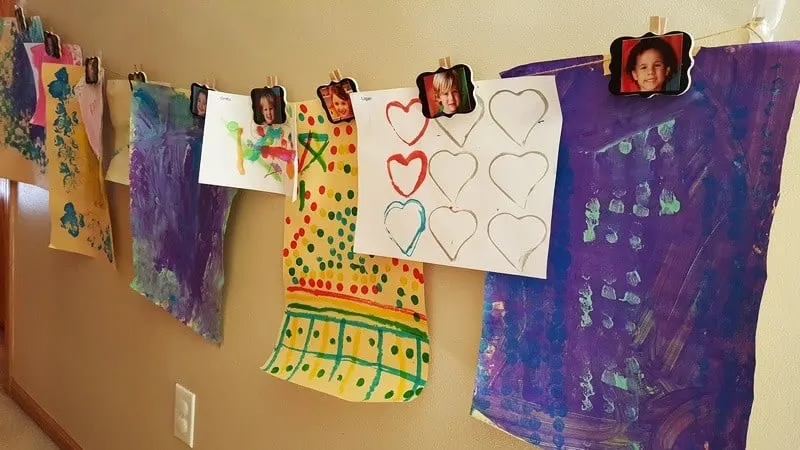
If you are unfamiliar with product vs. process art discussion, see this article from NAEYC about How Process Art Supports Preschoolers.
Basically, it’s about the process of creating rather than the end product that results. We want to provide quality materials and time for the child to explore them on their own, and come up with their own art, rather than direct every move.
Adults shouldn’t be changing or adding to art or telling a child it should look different. Process art supports a higher level of thinking.

For young children, I believe art should be very process oriented. It’s most important that we allow children to be creative and encourage creativity.
That means everyone might use materials differently, and every piece of art looks different. As with anything we do or offer to children, it should be developmentally appropriate.

We also need to recognize that art is different things to different people. We understand that when we view art – we might appreciate the colors but not want to buy it or have it displayed in our home. It’s personal.

It’s not art or it’s not creative if the end result looks like “something”? Of course not; that doesn’t make sense! Adults create art that “looks like something” all the time. Kids like to create crafts and projects that look like an end result too.
While they are creating, there is a process. In this case, we made juice glasses using pipettes and paint brushes to mix and paint with liquid watercolors. That is process art. It is optional to add the rest of the materials. Each child did theirs differently. Along with mixing, painting or using a paint dropper, there was the process of selecting additional materials, arranging and gluing.
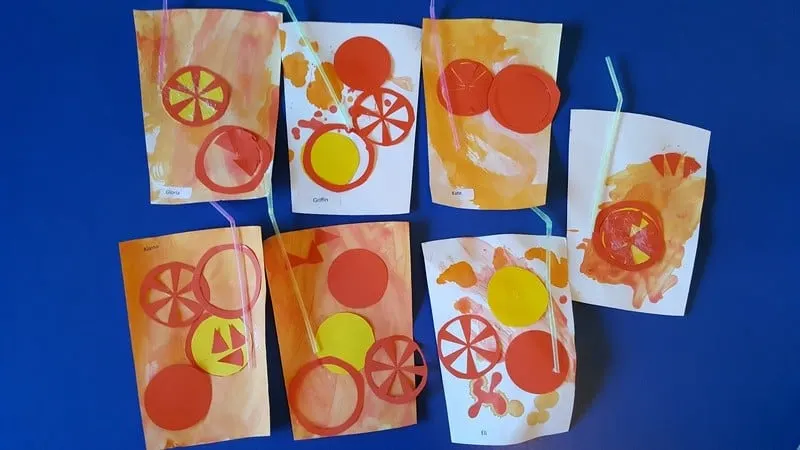
We have done things like Super Fun Syringe Painting, Bees Pollinate the Poppies, Icicle Drip Painting, Picnic Tablecloth painting, and Dipping, Soaking & Mixing. We take art outdoors even in the winter, paint outdoors on our easel and paint with sticks. We’ve made group art by painting on felt .
Like Ladonna at Woosely Academy, I agree with her post on The Process of Creating the Product in Pre-K. We might create a product in the end, but the process is what’s important. Art is and should be a messy open-ended exploration of various materials. Art isn’t just paint and paper. It can be yarn, string, beads, clay, paper, fabric, foam, wood, glue and whatever else you can think of! If you need some ideas, here’s 50 Process Art Activities for Kids.
Does that mean crafts are not creative or developmentally appropriate? No, there is no one statement fits all.
 Sometimes we make projects like this pizza. It’s fun to make a pretend pizza! Is it art? Well, it’s not an edible pizza, it represents a pizza. This is what we’d call product art. What happened is the child made choices about his work. He punched out the shapes, used what he wanted. Colored, cut, arranged and glued. I could observe what the child is capable of and he developed confidence in his abilities. And then we played restaurant! Often we create props for play. Is there less value in this activity because it’s product art? No. Really, it depends on what the objectives are for any given activity.
Sometimes we make projects like this pizza. It’s fun to make a pretend pizza! Is it art? Well, it’s not an edible pizza, it represents a pizza. This is what we’d call product art. What happened is the child made choices about his work. He punched out the shapes, used what he wanted. Colored, cut, arranged and glued. I could observe what the child is capable of and he developed confidence in his abilities. And then we played restaurant! Often we create props for play. Is there less value in this activity because it’s product art? No. Really, it depends on what the objectives are for any given activity.
Some art is temporary, like on the chalkboard. 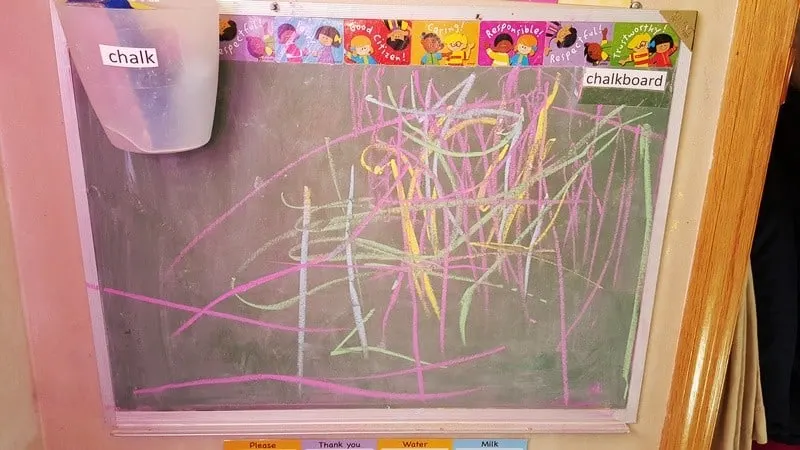
I’ve been asked – Does Mother Goose Time offer process art? Or only product art?
The answer is yes. As state by Christine at Chicken Nugget Mom, who also used Mother Goose Time: “Process vs. product is set by the teacher not the curriculum itself. For me, I have used every single MGT art with process as my priority, not the product.”
One of the benefits of Mother Goose Time curriculum is that it’s very flexible. Every child care provider, parent or teacher uses the materials differently, to meet their needs.
Mother Goose Time supplies unique tools for painting like: toothbrushes, pipettes, pokey balls, sponges, cotton balls and makeup applicator type brushes. Usually, these supplies can be kept and reused. They are great additions to our art cart.
Each month, the Mother Goose Time kits include a wide variety of materials. The children are exposed to lots of new ideas and ways to be creative.
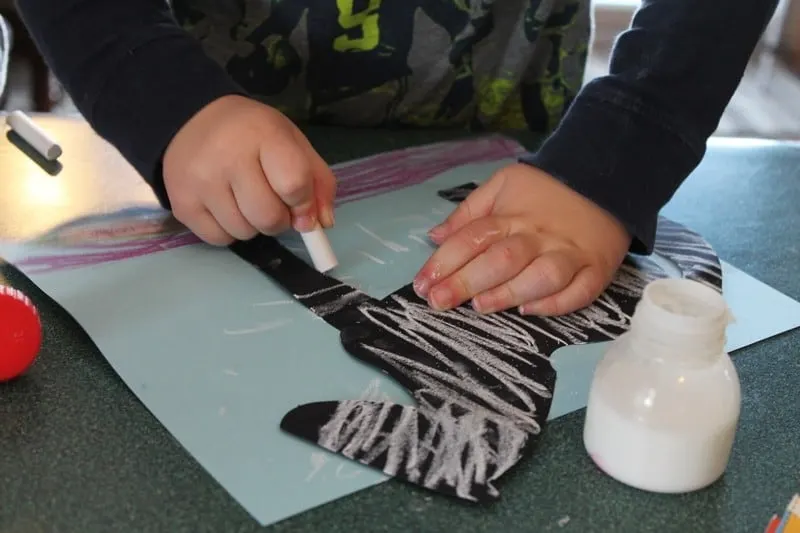
I absolutely agree with this statement from this article: Creative Play in Art & Craft
The opportunity to ‘play’ with a range of art and craft materials in a relaxed atmosphere, where the emphasis is on the playing and not on producing something successful (or even something unsuccessful!), can be both very exciting for a child and very soothing and comforting as a sensory experience. Although there are techniques and methods to be learned, there is not one correct way to create, and the very nature of art and craft encourages individuality, diversity, experimentation and innovation. A painting of a tree does not have to be identifiable as a tree!
This is why I have an art cart available at all times for my child care children to explore art materials on their own. It is a very successful method for offering choice and opportunity for preschoolers.

I also like the points that Brenda M of Sweet Smiles Preschool makes: “Let there be a time to teach, and then a time for free-choice. When the free-choice time is taking place, encourage free art with an open art station that is open at all times with varying materials.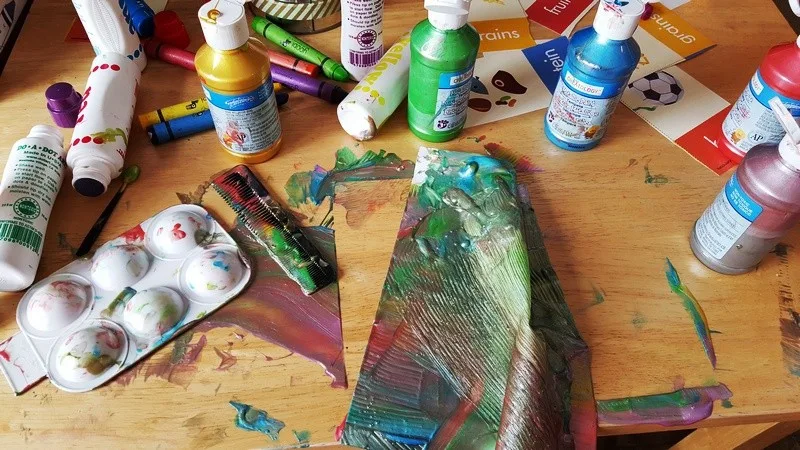
Sometimes, this is what it looks like. Children can learn to do things for themselves, including clean up their messes.
Again, there can be a balance in types of art experiences.
What can be learned through product art creation?
- cutting skills
- self control – how much glue?
- fine motor skills
- following directions
- being creative with materials given
- thought process – what comes first, second, third?
- eye-hand coordination
- problem solving
- general knowledge- how many legs does a cow have?
- using tape, glue, string, paint, crayons. Which works best for my project?
Can these all be learned through process art too? For sure. Again, there are many ways to learn and many ways to even go about using product art.

During our Going on Safari theme, we made lion masks. The children created their own play prop for additional activities relating to our theme.

In December, we painted teapots with tea bags with the Sights and Sounds of Winter theme. This is process art using a tea bag. Is it less meaningful because we painted on a teapot shaped paper and we can say we made teapots?

Last fall when we did this activity – Pounding Colors, each child ended up with a small piece of fabric to take home. One mom pulled that out of her child’s cubby and said “Umm…what’s this?” I quickly explained. She said “Oh, it looks like a dirty wipe!” LOL We had a good laugh. Once I explained the activity, she thought it was pretty cool. Everything we create isn’t necessarily something parents will choose for the scrapbook or memory box and that’s okay.

As child care providers and early childhood educators, we know there can be a struggle to meet the expectations of parents who may not understand. This is where parent newsletters, blogs, posts on social media or a conversation can help educate the parents on the importance of the process, not just the product.

Read about Deborah Stewart’s transition from product to process art activities here. Consider how you can add more process art to your art experiences.
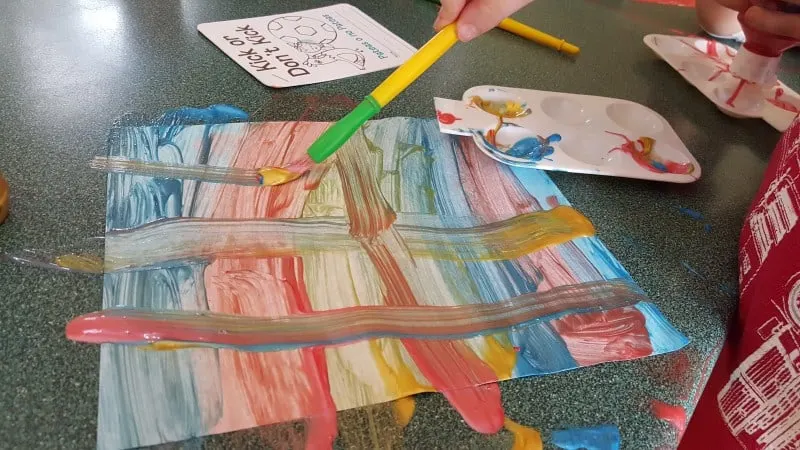
As there are many ways to learn, there are many ways to teach. This applies to art as well as any other concept we teach children.
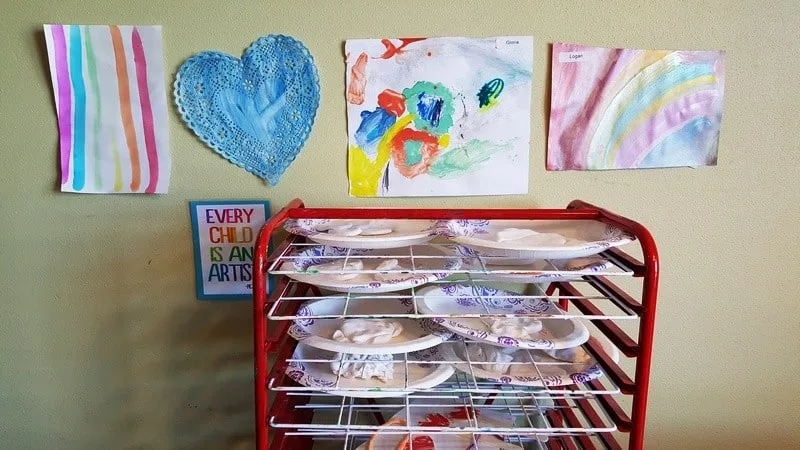
Is there Hope for a Return to Common Sense in Early Childhood Education? Good question. Not only should we not push children to acquire more and more knowledge at such a young age, as professionals, let’s have a little balance in our philosophies and “best practices.”

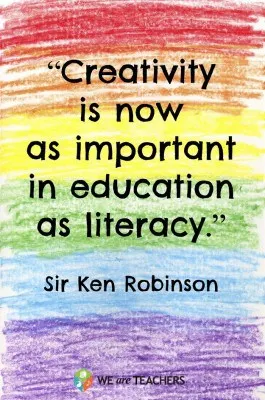
Easter Preschool Activity - Letter Recognition Egg Craft {Free Printable}
Wednesday 22nd of May 2019
[…] I also think there’s a place for more structured art activities. […]
Transforming Product Art into Process Art – ROSEMARY NGUYEN
Friday 6th of April 2018
[…] Value of Both Product Art & Process Art In Early Childhood (2016, February 24). In Things to Share and Remember. Retrieved April 6, 2018, from https://www.thingstoshareandremember.com/value-product-art-process-art-early-childhood/ […]
Kristin Cook
Monday 24th of October 2016
Oh my gosh! That cow with glove utters is so cute! That made me laugh and smile!
I love how you work with your kids in this process. That is wonderful and I think it will be beneficial to them :)
Stacy
Monday 24th of October 2016
Ha ha, isn't that cute?! Thank you...
Art is Smart
Saturday 1st of October 2016
[…] Value of Both Process and Product Art in Early Childhood. […]
Race Track Car Painting Printable
Tuesday 3rd of May 2016
[…] Painting with cars is a wonderful process art activity for children and commonly done. It’s play, it’s art, it’s cause and effect, it’s fun! Painting is even more fun with cars on a race track! Use any color of paint and Hot Wheels or a larger car for smaller hands to grasp and move across the paper and paint. This fits into any day or with a transportation theme for toddlers and preschoolers. Download the Race Track Car Painting Printable and print the track on cardstock for best results. Read more about the value of both process and product art here. […]